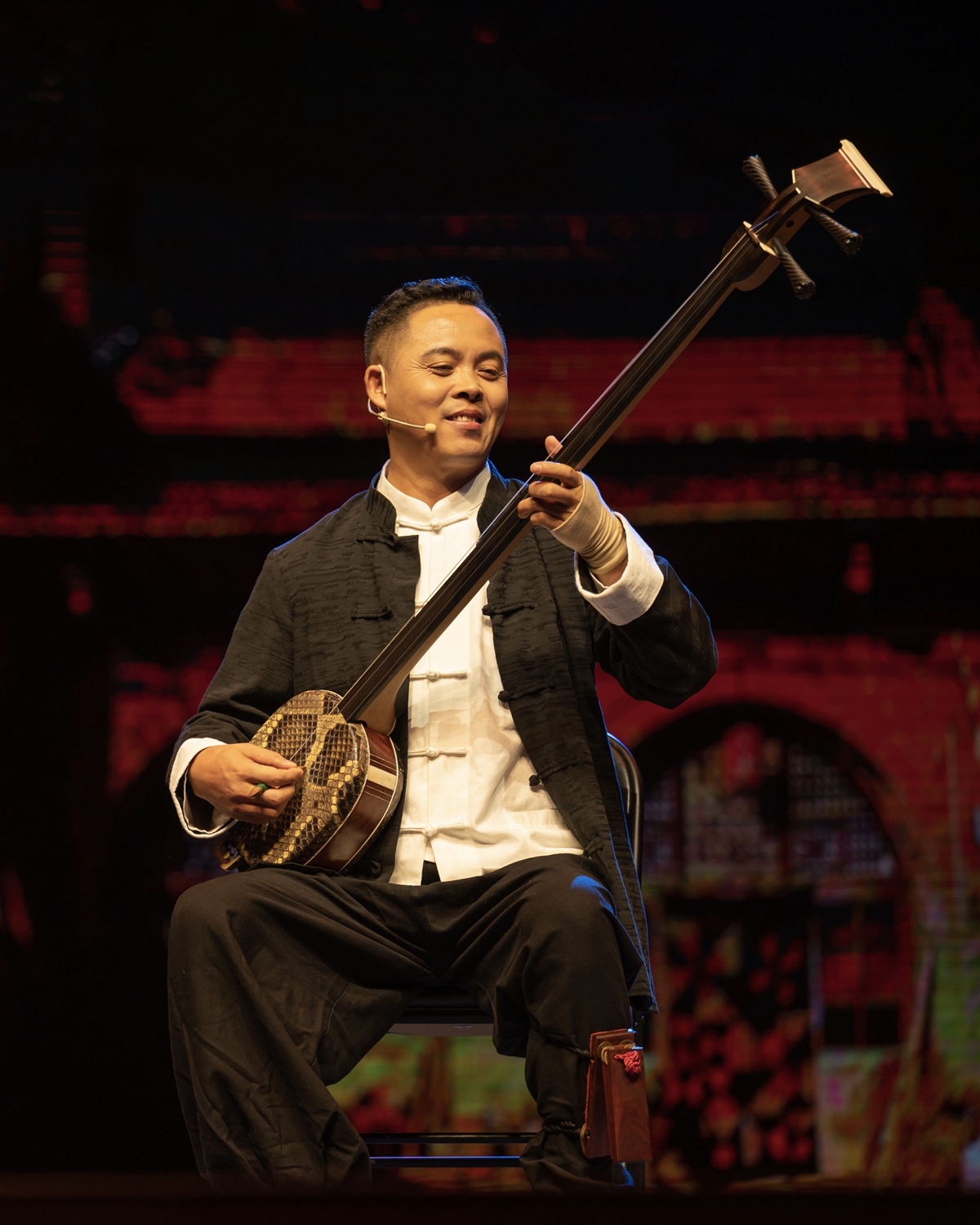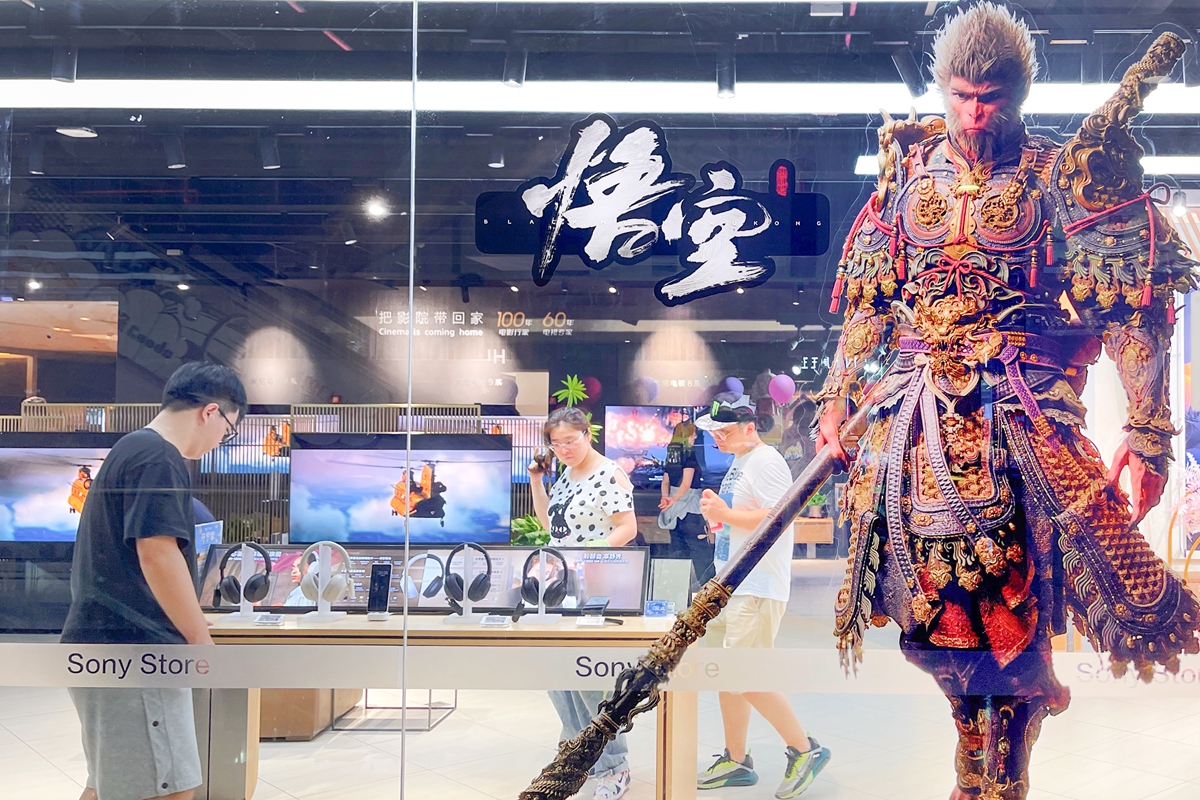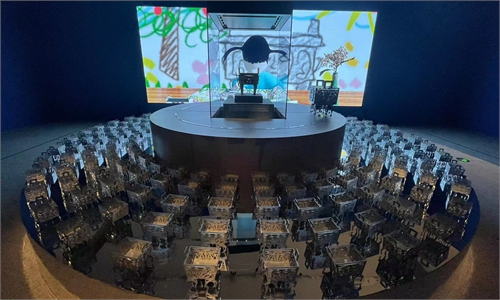ARTS / CULTURE & LEISURE
Artist takes Shanbei storytelling to world stage with popular Chinese game ‘Black Myth: Wukong’
Reviving tradition through innovation

Chinese artist Xiong Zhuying performs Shanbei storytelling. Photo: Courtesy of Xiong Zhuying
In the opening of the second chapter of the Chinese AAA game Black Myth: Wukong, players find their character, "The Destined One," gravely injured on the yellow sands, was only saved by the mournful strains of the folk drama in the north of Northwest China's Shaanxi Province, or Shanbei in Chinese, performed by the headless monk. The evocative lines "Success and failure, life and death, all are beyond reason," and the poignant, melancholic tone of the performance resonate deeply with players.This piece, lasting less than two minutes, has garnered over 10 million views on social media. It was performed by Xiong Zhuying, the inheritor of the art of Shanbei storytelling, a kind of intangible cultural heritage.
Among all of the striking and exciting elements global gamers reflected on, they shared a common feeling of "ruggedness and desolation" upon hearing the piece of Shanbei storytelling for the first time.
"The traditional elements I used to perform have taken on a new life in the game. Although it may seem very traditional, this collision has actually created something popular that resonates with all audiences," Xiong told the Global Times.
As traditional art forms nowadays struggle to find their place in modern media spaces, Xiong's combination of Shanbei storytelling with modern gaming has attracted world attention. International players, despite not being fluent in Chinese, or Putonghua, find themselves captivated by the rhythm and emotion conveyed, listening to it repeatedly and moving to its beat.
"This collaboration has really made me feel that what is ethnic is also universal," Xiong said.
Extensive revisions
It all began in 2022 when the game's production team reached out to Xiong with an intriguing proposal.
"I was thrilled at the prospect," Xiong recalled. "Shanbei storytelling is a vital part of our cultural heritage, and I saw this as an opportunity to introduce it to a broader audience."
The initial challenge was to adapt the traditional lyrics and performance style to fit the game's narrative. Xiong noted that the original lyrics provided were somewhat rigid and didn't quite capture the essence of Shanbei storytelling.
"The lyrics need to rhyme, with seven characters per line, and be catchy and easy to sing," Xiong explained. He noted that the musical style should allow one person to play multiple roles, expressing a range of emotions like joy, anger, and sorrow. The performer should shift between being a storyteller and the characters within the story, jumping in and out of different roles, reflecting a style of dynamic character portrayal.
After extensive revisions and numerous performances, Xiong crafted a version that harmonized with the game's aesthetic while preserving the integrity of the traditional art form.
The new form complements the eerie and otherworldly environment of the game. Xiong noted that the northwestern singing style and pronunciation have an inherent bleakness that aligns with the character's state.

Promotional material for Black Myth: Wukong on display at a store in Nanjing, East China's Jiangsu Province on August 24, 2024 Photo: VCG
A long path
In 2016, Shanbei storytelling was included in the first batch of the National Intangible Cultural Heritage List in China. This significant form of traditional narrative art in the vast and remote area in Northwest China is particularly popular in northern Shaanxi, including areas like Yan'an and Yulin.
Historically, performances were conducted by blind artists, who sang and played instruments such as Sanxian, a three-stringed traditional Chinese lute, or pipa, a four-string plucked lute. It was not only a form of performing art, but also a way to make a living.
"I was exposed to this art form from a young age," he recalled. "Listening to cassette tapes of Shanbei performances and attending local shows instilled in me a deep appreciation for this tradition." He then met his master at a temple fair. The master told him that he might make a better living if he learned Shanbei storytelling.
His professional career began in 2009 when he joined the Hengshan District Cultural Center as a special artistic talent. Over the years, Xiong has refined his craft and expanded the boundaries of Shanbei storytelling. His performances have earned him accolades and opportunities to showcase his art on international stages, including at the Chinese Quyi (folk art forms) Festival in Paris and the Bachshi International Art Festival.
But he still went through a very tough period.
"I could barely support my family at the time, but it was the passion and the opportunity that made me persist," Xiong said.
The opportunity Xiong got was to perform for the animated film Xuanmen: The Faces of All Living Beings. The success of this project, which combined Shanbei storytelling with animation, bolstered Xiong's confidence in cross-genre fusion.
"When I first combined Shanbei storytelling with animation, I wasn't sure how it would be received. But the positive response gave me the confidence to explore other innovative collaborations," Xiong said.
For Xiong, innovation is not about abandoning tradition but rather enhancing it. His approach involves blending traditional Shanbei storytelling with modern elements, including rap and pop music.
"After the collaboration, I found innovation is crucial to keeping Shanbei storytelling relevant," he said.
Beyond his professional achievements, Xiong is also deeply committed to preserving and promoting Shanbei storytelling. He also noted that once the excitement dies down, he wants to actively teach and mentor the younger generations to ensure that the art form continues to thrive.



